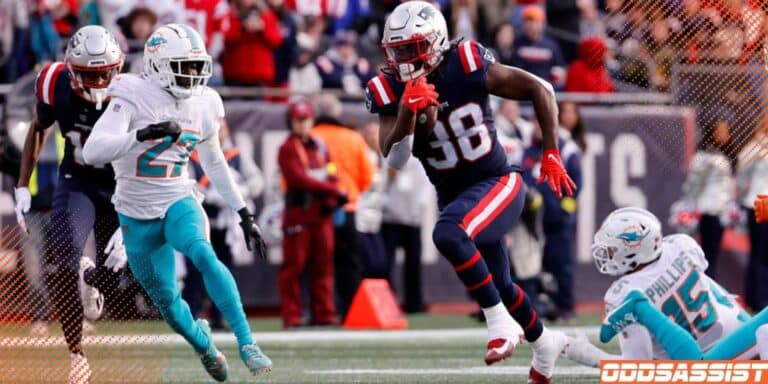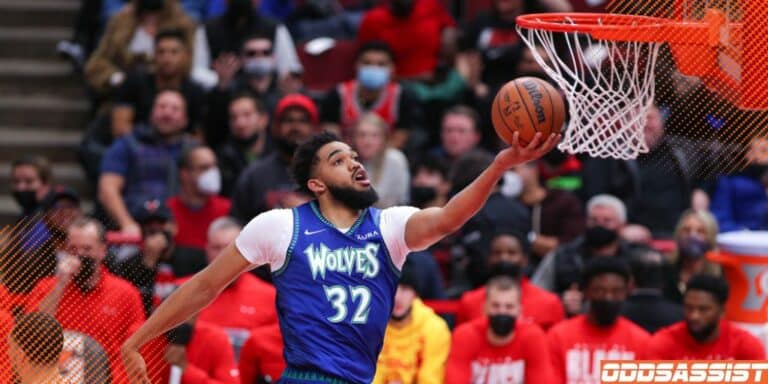Companies featured on this page may be our partners who compensate us if you sign up for one through our links. This doesn't affect our ratings or opinions in any way. Must be 21+. Gambling Problem? Call 1-800-GAMBLER. See full disclosure.
When you bet the total on a sports game, you decide whether the final score will be over or under a certain number.
Typically, the total is the sum of both teams’ final scores for a game. There are, however, other type of total bets such as the total points scored for just one team and the total point scored in the first half for both teams.
As the names imply, betting the Over means you think the final score will be higher than the total while betting the Under means you think the final score will be lower than the total.
If the total on a game between the Eagles and Cowboys is set at 44.5, for example, the Over would hit if the final score is 27 to 24 (51 points total) while the Under would hit if it is 21 to 17 (38 points).
When you bet the total, there are three possible outcomes:
- Win: If you correctly predict that the final score will be over or under the total.
- Lose: If you incorrectly predict if the final score will be over or under the total.
- Push: If the final score is equal to the total, the bet pushes and you receive your money wagered back.
Note that total bets on the entire game always include overtime.
Our guide to betting totals goes over how totals work, how the odds and lines work, and how much money you make from total bets.
Examples of Total (Over/Under) Bets
Total bets are available in a variety of sports including football, basketball, baseball, hockey, and even sports like boxing and MMA.
Here are some example total bets from the FanDuel Sportsbook:
NFL Total

An example of the Over hitting would be 28-27 (55 total points), an example of the Under hitting would be 27-21 (48 total points), and an example of a push would be 28-24 (52 total points).
>> Read More: Best NFL Betting Sites
NBA Total

An example of the Over hitting would be 118-115 (233 total points) while an example of the Under hitting would be 115-110 (225 total points).
>> Read More: Best NBA Betting Sites
MLB Total

An example of the Over hitting would be 6-5 (11 total runs), an example of the Under hitting would be 4-3 (7 total runs), and an example of a push would be 5-4 (9 total runs).
>> Read More: Best MLB Betting Sites
NHL Total

An example of the Over hitting would be 4-3 (6 total goals) and an example of the Under hitting would be 3-2 (5 total goals).
Most NHL betting sites count goals scored in overtime towards the total on NHL games. If a game goes into a shootout, the winner will have one goal added to their score (and therefore the total).
For example, say at the end of the third period of a hockey game, the score is 3-3 and the total is 6.5. No matter whether a goal is scored in overtime or if a team wins in the shootout, the final score would be 4-3 and the Over would hit.
>> Read More: Best NHL Betting Sites
Boxing/MMA Totals
Outside of totals on most popular team sports, you can also usually bet on the total amount of rounds a boxing or MMA match will go for.
For example, the May 2021 boxing match between Canelo Alvarez and Billy Joe Saunders had a total of 10.5 rounds. Since the fight was waved off after the 8th round, betting the Under on the total would have been a winning bet.
How Odds Work on Total Bets
Let’s take a look at how odds work on total bets for specific sports.
Football & Basketball
For football and basketball, you will typically see odds of around -105 to -120. The odds don’t often get much lower than this because sportsbooks will change the line as opposed to continuing to change the odds.
>> Don’t know how to read odds? Check out our guide to reading betting odds.
Using the NFL game above between the Cowboys and Bucs, for example, we see a total of 52 with the odds at -110 for both sides. If a lot of money comes in on the Over, the odds on the Over will likely start shifting down towards -120.
If money still keeps coming in at -120, the total line will likely move to 52.5 at odds of around -105 to -110. This type of line movement is very common in football and basketball, especially from the time lines first come out to the start of the game.
Baseball & Hockey
The totals on baseball and hockey games work the same way they do for football and basketball, but there is usually a wider range of odds you’ll see.
Since hockey and baseball are much lower scoring than football and basketball, you’ll often see lines anywhere from -130 to +130—and sometimes even more in either direction. Sportsbooks are more likely to shift the odds further before they move the total line.
How Over/Under Lines are Set
Market-making sportsbooks use complex processes to set total lines that include incredible amounts of data and complex algorithms. Other sportsbooks simply copy the lines of these market-making books.
Once the lines are released for games, sportsbooks will shift the odds and lines as necessary based on the money that comes in. If a lot of people bet on the Under, for example, sportsbooks will start giving worse odds on it and may eventually move the line to a half-point or full point lower.
Like lines offered on spread bets and moneylines, the lines sportsbooks offer on totals typically end up being very close to the end result.
Since sportsbooks charge a vig on the markets they offer (which is why the standard odds are -110 instead of +100), it is very hard to win betting totals long term.
You must win 52.38% of your bets to make money assuming the odds are all -110. This may not seem like a lot, but with how well sportsbooks set lines, it can be quite difficult to win much more than 50%.
If you primarily focus on live betting, you'll have to win even more of your bets as books typically charge more vig than the standard -110.
Note that most sportsbooks also offer alternate totals, which allow you to shift the over/under in exchange for a higher or lower payout depending if you move the line in your favor or against it.
How Much Money You Can Make Betting Totals
Like all types of sports bets, how much money you make on an Over/Under bet depends on the odds.
You can learn how to find your winnings from American Odds here or use our Betting Odds Calculator to calculate winnings in any odds format, but we’ll go over some quick examples as well:
- Example 1: $100 bet on Over 52 at -110 odds would pay out $90.91
- Example 2: $25 bet on Over 44 at -110 odds would pay out $22.73
- Example 3: $10 bet on Over 46.5 at +100 odds would pay out $10
Note that the above examples go over how much you would win, not including the amount you wagered. Your total payout would include both the winnings (shown above) as well as the amount you wagered.
In the third example, you would receive a total of $20 from the sportsbook ($10 wagered + $10 winnings).







